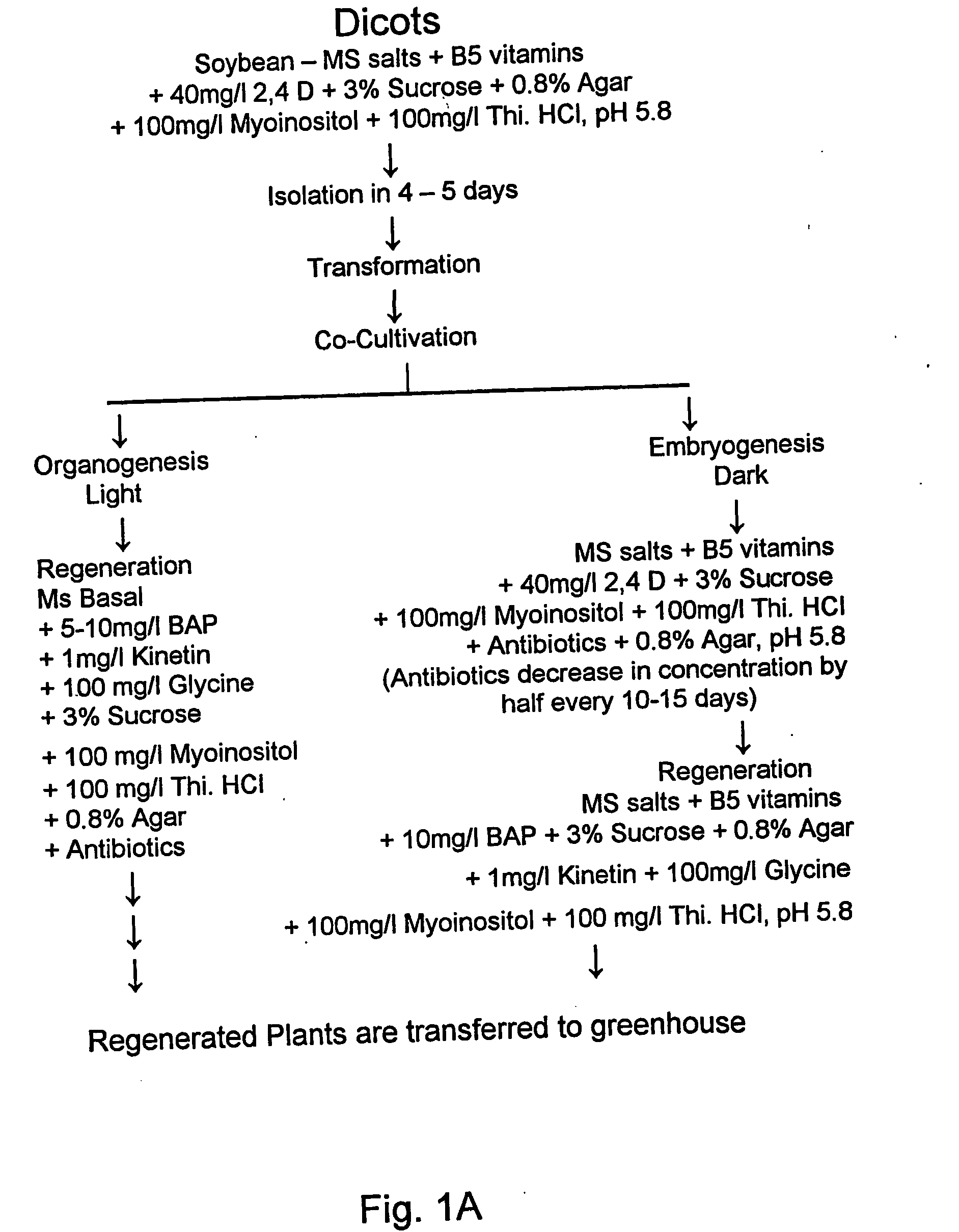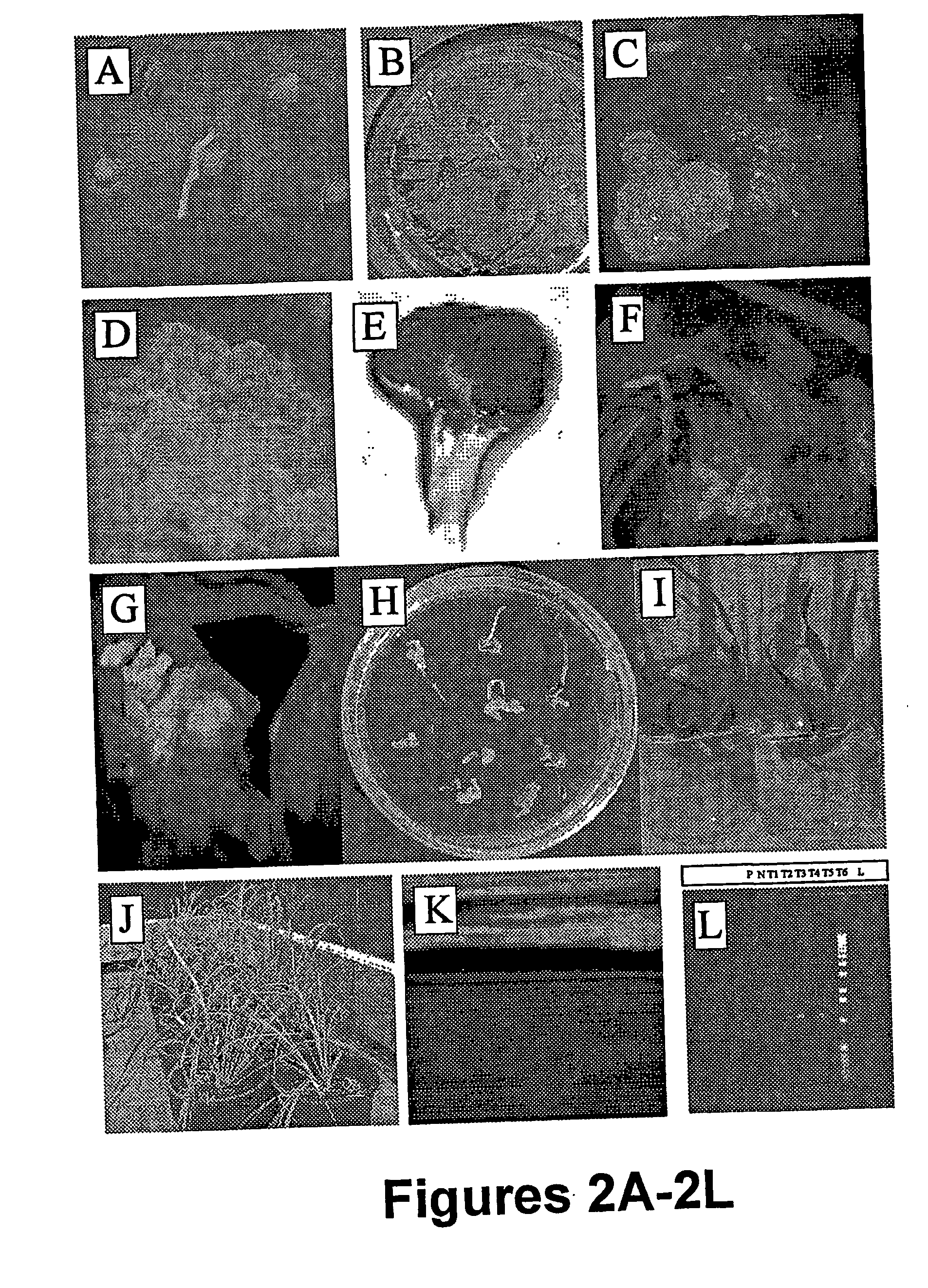Method for transformation of mono-and di-cotyledonous plants using meristematic tissue and nodal callus from dicotyledonous plants
a dicotyledonous plant, meristematic tissue technology, applied in the direction of plant genotype modification, fermentation, biochemistry apparatus and processes, etc., can solve the problems of low dna delivery frequency to protoplasts following peg-mediated dna uptake, inability to significantly improve, and inability to identify specific cell culture systems, so as to increase the production of virus-free gladiolus
- Summary
- Abstract
- Description
- Claims
- Application Information
AI Technical Summary
Benefits of technology
Problems solved by technology
Method used
Image
Examples
example 1
In Vitro Germination Studies in Tripsacum (Eastern Gamagrass)
[0149] Sterilization of Seeds / Preparation and Culture of Explants:
[0150] Seeds of commercial variety "Pete" were obtained from a commercial grower, Shepherd Farms, Clifton Hills, Mo. Three different protocols were studied to optimize the seed germination:
[0151] a) The seeds from the commercial variety "Pete" were rinsed with detergent solution for 10-20 minutes. Then the seeds were rinsed with water for 5-6 times. Later the seeds were transferred to a sterile beaker in a laminar flow hood. The seeds were then treated with 0.1% HgCl2 for 10-15 minutes. Later they were washed with sterile water for 6-8 times and cultured on Murashige and Skoog's medium supplemented with an auxin, 2,4-dichlorophenoxyacetic acid (2-5 mg / l).
[0152] b) The seeds from the commercial variety "Pete" were rinsed with detergent solution for 10-20 minutes. Then they were rinsed with water for 5-6 times. Later the seeds were transferred to a sterile bea...
example 2
In Vitro Regeneration Studies in Tripsacum
[0168] Shoot meristems from Eastern gamagrass were cultured on MS medium supplemented with 100 mg / l Myo-inositol and 400 mg / l Thiamine HCl and hormone, 2,4-D at 5 mg / l. The cultures were kept in dark for induction of callus. Callus initiation was seen from day 5 after transfer to the medium. The callus induction frequencies in a range of experiments varied from 90-95% (Table 2). The mean number of shoots per callus varied from 2-5.
[0169] Calli with numerous somatic embryos were formed in 15-30 days. The calli with numerous somatic embryos were transferred on to MS medium supplemented with 100 mg / l Myo-inositol and 100 mg / l Glycine and hormones, Kinetin at 1 mg / l and BAP at 10 mg / l. The plant regeneration frequencies varied from 48 to 59% in a range of three experiments.
2TABLE 2 Callus induction and Plant Regeneration frequencies in Tripsacum # Shoot # producing Callus No of meristems callus / Induction shoots / Regeneration Ex # cultured shoot...
example 3
In Vitro Regeneration Studies in Corn
[0170] Seeds of commercial variety P15 RA 3737 from the Indiana Crop Improvement Association, Purdue were used. The seeds were rinsed with detergent solution for 10-20 minutes. Then they were rinsed with water for 5-6 times. Later the seeds were rinsed with 70% ethanol for 2-5 min followed by several rinses with water. Then the seeds were transferred to a sterile beaker in laminar flow-hood. The seeds were then soaked in 0.1% HgCl2 for 10 min. Later they were washed with sterile water for 6-8 times and cultured on Murashige and Skoog's medium supplemented with an auxin, 2,4 dichlorophenoxyacetic acid (2-5 mg / l).
[0171] After culturing the seeds from the above method on MS media for 3-5 days, the shoot meristems were cultured on Murashige and Skoog's medium supplemented with an auxin, 2,4 dichlorophenoxy acetic acid (5 mg / l).
[0172] Results
[0173] Shoot meristems from corn were cultured on MS medium supplemented with 100 mg / l Myo-inositol and 400 mg / ...
PUM
| Property | Measurement | Unit |
|---|---|---|
| time | aaaaa | aaaaa |
| time | aaaaa | aaaaa |
| length | aaaaa | aaaaa |
Abstract
Description
Claims
Application Information
 Login to View More
Login to View More - R&D
- Intellectual Property
- Life Sciences
- Materials
- Tech Scout
- Unparalleled Data Quality
- Higher Quality Content
- 60% Fewer Hallucinations
Browse by: Latest US Patents, China's latest patents, Technical Efficacy Thesaurus, Application Domain, Technology Topic, Popular Technical Reports.
© 2025 PatSnap. All rights reserved.Legal|Privacy policy|Modern Slavery Act Transparency Statement|Sitemap|About US| Contact US: help@patsnap.com



